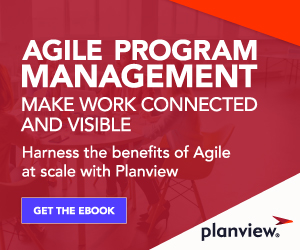
By now, I hope you’re well acquainted with our four-part Agile Program Management discussion and demo series. And, especially, my supporting blog series where I’ve shared highlights from each discussion to offer ways to help improve your approach to scaling Agile.
This blog is dedicated to Part 4: Agile Program Management – Eating the Cake, too! which summarizes the top things to look for in an Agile Program Management solution and specifically leveraging a Kanban solution.
As a recap, here’s access to the complete series and the supporting blog summary for each of the sessions we held. Check them out for a deeper dive into each area of focus.
6 Things to Look for in an Agile Program Management Solution
1. Visualize, Track, and Manage Agile Work a the Team and Program Level
For many teams Kanban software has proven to be a successful approach to Agile Program Management. Look for the ability to connect epics and features from the team-level boards to a program-level board with customizable parent to child hierarchy that can be leveraged across epics, features, and stories.
Agile Organizations need:
- A central location for Agile teams to manage work: If you have multiple teams on a single release train or you’re managing multiple release trains with many teams, Kanban is a great first step to getting teams coordinated to start visualizing current state of work.
- A central location or Agile coaches and leaders to manage the Agile Program: It is all about connecting team(s) effort with corporate strategy. Once teams are working within their respective Kanban boards, organizations can connect teams of team’s work – aka Agile Release Train (ART) – into a single program-level Kanban board.
2. Connect to Your Agile Team Tools
Your Agile teams are likely leveraging technology like Jira Software or Azure DevOps; your teams don’t want to change. Instead of creating disruption and potential roadblocks to delivery, look for a solution that allows you to integrate with other Agile team tools to create program-level views of work delivery across multiple teams no matter where their work is managed. For an example of a common use case, check out the Agile Integrations blog.
3. Visualize Dependencies, Risks, and Impediments
Dependencies are the relationships between work items that occur when one work item requires the input of another to be completed or cannot be started until a previous work item is done. Understanding the relationships between work items is imperative to improving workflow across teams and ARTs. Look for a solution that can help you visualize and track dependencies across multiple teams to avoid conflicts and support your ability to make decisions and pivot as business needs change.
4. Streamline Quarterly or Program Increment Planning
Quarterly or Program Increment (PI) planning is an essential part of establishing what teams will deliver in the coming 12 weeks. Look for a solution that connects teams of teams so that PI planning is digital and streamlined. This means, using a solution to visualize features, enablers, objectives, milestones and more. Check out the blog for 4 tips to use Planview AgilePlace for PI Planning at the program level.
5. Continuously Improve with Out-of-the-box Agile Metrics
As part of any Agile practice, you must be able to review progress metrics (at the team level and the program level) to identify risks and improve processes. Look for a solution with out-of-the-box Agile metrics that provide both “current state” and “historical” insights to advance your approach to early and continuous delivery. Access to this type of data ensures the right work is prioritized and delivered while aligned to corporate strategy.
You must be able to quickly answer questions like:
- What type of work are we working on?
- What work items have missed their planned start and/or finish date?
- What’s at risk?
- Are we on track to complete the planned work by the deadline/end of this iteration/sprint?
- What work is in progress as it flows through the Kanban system?
- What work is completed by the planned finished date vs the actual finish date?
6. Advance Reporting with Custom Reports
Because every organization is different, look for a solution that supports your organization’s need to create custom reports leveraging the data connected from multiple team-level Kanban boards for metrics unique to your organization.
The right Agile Program Management solution will meet you where you are in your Agile journey. Start off small and advance your Agile Program as you learn. We hope you have found this webinar series and demo discussion helpful. For more information about Agile Program Management, we invite you to sign up for a complete end-to-end demo.




